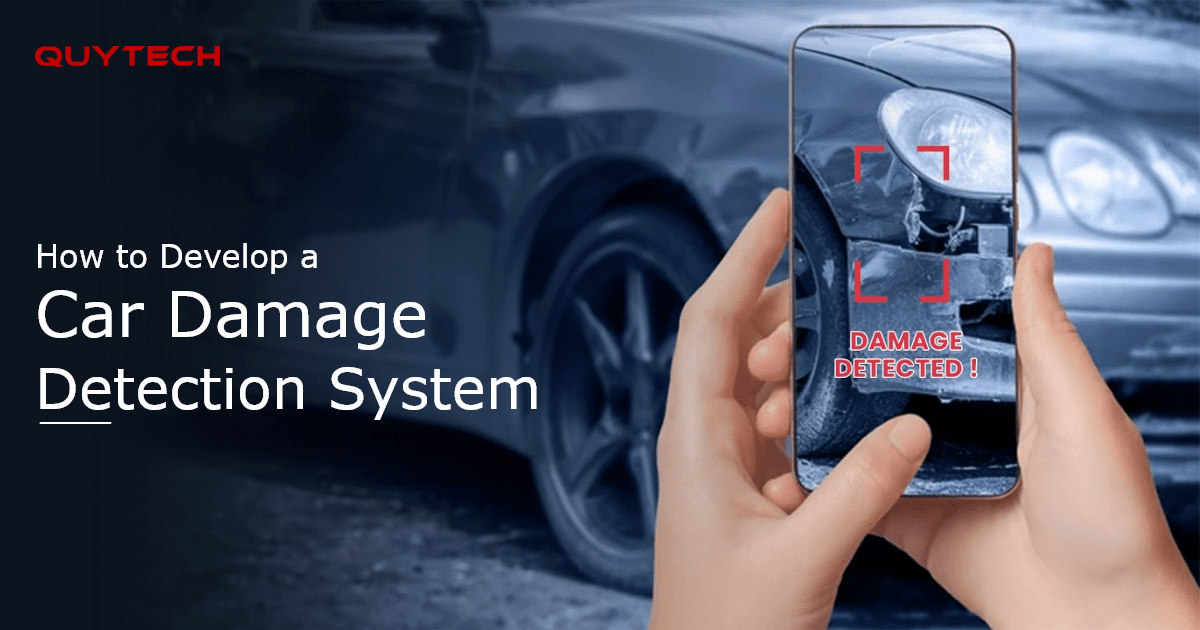Like any other industry, the automotive industry is undergoing a massive transformation driven by technologies like AI, computer vision, deep learning, IoT, and more. Processes that used to take days or even weeks can now be completed in minutes. One such process is identifying and detecting car damages, such as cracks, dents, and scratches.
It’s not that the automotive industry alone needs car damage detection or vehicle damage detection systems. Industries like insurance also heavily rely on accurate and efficient damage assessment for claims processing, risk evaluation, and fraud prevention.
Similarly, car rental companies or even individuals need AI car damage detection or computer vision car damage detection systems to recognize car damages and minimize disputes while ensuring accurate billing.
As per an online report, the car damage detection market is expected to reach US $7.2 Billion by 2033. The market is anticipated to grow at a compound annual growth rate (CAGR) of 8.5% from 2026 to 2033.
An automated car damage detection system powered by advanced technologies like AI, computer vision, and others not only saves time and cost but also brings the highest degree of accuracy in the output and saves a whole lot of effort. If you belong to an industry that can benefit immensely from AI car damage detection software and looking to build one, this blog is all you need to read.
Here, we have provided a step-by-step process to develop car damage detection systems. To ensure you know the inside-out of such software, we have also provided detailed answers to how a car damage detection software work, what are its benefits, what technologies are required to build a car damage detection system, and which industries can benefit from such a software, and a lot more.
Why wait? Let’s begin!
How Does a Car Damage Detection System Work?
A car damage detection system leverages computer vision, artificial intelligence, and a few other technologies to analyze an image or video and detect damages like scratches, dents, and cracks.
Step 1: Collecting the Vehicle’s Image
The first step involves capturing images or videos of the vehicles from different angles using a high-resolution camera, smartphone, sensors, or 3D scanner. The system connects with these devices using IoT and other technologies.
Step 2: Data Analysis
The next step involves preprocessing the captured data by enhancing images, ensuring consistency in collected data, and removing data that is not required. This unneeded data is the part/area of the vehicle that doesn’t have any scratches or damages.
Step 3: Extract Features to Identify Relevant Characteristics
In the third step, a car damage detection system uses advanced machine learning algorithms to identify or recognize edges and contours in the image to find dents and other irregularities showing vehicle damage. It also involves analyzing texture and color discrepancies that may show the damage.
Step 4: Detecting and Classifying the Damage
The car damage detection system uses machine learning or deep learning models (pre-trained on vast datasets of hundreds of thousands of images of damaged and undamaged vehicles). These well-trained models analyze the extracted features in step 3 to detect damage, classify it, and mark the location of the damage on the vehicle.
Step 5: Assessing the Damage and Generating a Detailed Report
The vehicle damage detection system locates the exact location of the damage and figures out its severity. It then generates a detailed damage report, including an image of the damaged area/part, a description of the type of damage and its severity, and estimated repair costs.
Step 6: Data Storage and Transfer
In the last step, an automated vehicle detection system stores this report or transfers its data to other systems, like an insurance claims processing software or vehicle maintenance system to facilitate the execution of further actions.
Applications of a Car Damage Detection System
A car damage detection system has multiple use cases for diverse industry verticals. For instance, it can help the insurance industry to speed up insurance claims while keeping insurance fraud at bay.
For a better understanding of the use cases of a car damage detection system, we have categorized these applications according to different industries. Let’s take a look:
Applications of a Car Damage Detection System in the Insurance Industry
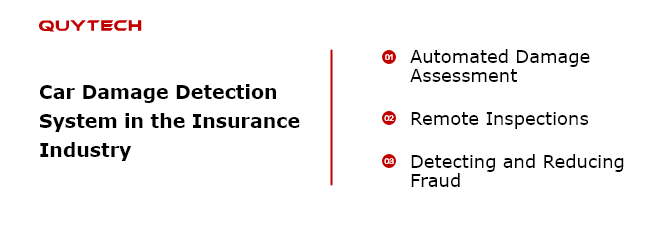
Automated Damage Assessment
When an individual claims for vehicle damage insurance, the insurer has to perform a manual inspection of the vehicle to assess the damage and its type and severity. A car dent detection or car scratch detection systems automate this process to save time and effort. Such systems can auto-analyze images or videos of the car or vehicle to identify, classify, and quantify the damage.
Remote Inspections
A vehicle damage detection system enables the policyholder to submit images or videos of their damaged vehicles without actually taking their vehicle for manual inspection. This saves a lot of time, effort, and hassle, especially if the damage is minor or the vehicle is in a remote location.
Detecting and Reducing Fraud
An intelligent vehicle damage detection system powered by artificial intelligence or computer vision can precisely compare images from different sources to find out if the damage is natural or done on purpose to claim insurance. With such reports, insurance companies can keep fraud at bay.
Applications of a Car Damage Detection System in the Car Rental Business
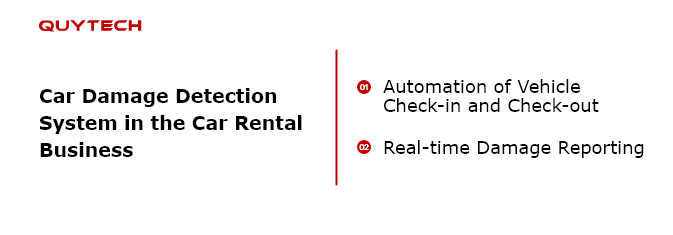
Automation of Vehicle Check-in and Check-out
To identify and assess the car damage, the vehicle damage detection software streamlines check-in and check-out processes, wherein, it auto-captures the images of the vehicle before handing it over to the customer for a particular period of time. This minimizes disputes that arise when a customer doesn’t take responsibility for the damage done to the rented vehicle.
Real-time Damage Reporting
By developing a car damage detection system, car rental companies can get real-time alerts on their vehicle. With this, they can promptly take action and also reduce vehicle downtime while enhancing the customer experience with an accelerated rental process.
Applications of a Car Damage Detection System in the Automotive Sector
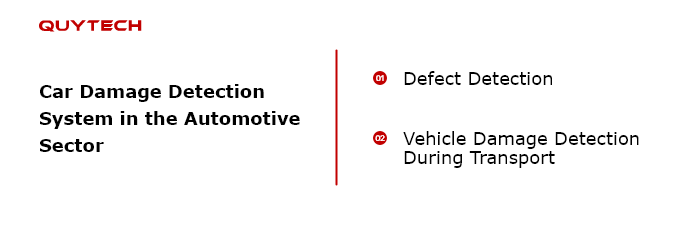
Defect Detection
Car damage detection software can be used by the manufacturing and automotive industries to detect defects on the car manufacturing or assembly line. The system can help ensure consistent quality while minimizing the chances of defects.
Vehicle Damage Detection During Transport
The system can detect the paint finishes to find imperfections or damages, such as paint scratches, bubbles, and unevenness. It ensures consistent quality in each vehicle that is transported from one location to another.
Explore More: Computer Vision Use Cases in Manufacturing: Explore Unique Applications for 2025
Applications of a Car Damage Detection System in the Logistics Sector
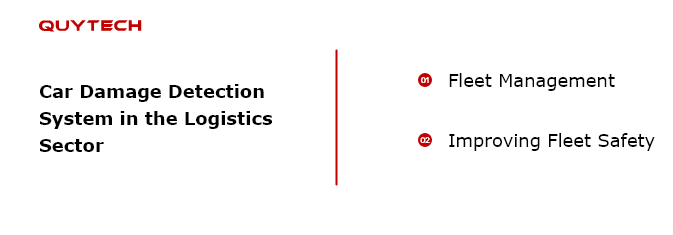
Fleet Management
The vehicle damage detection system can assess the vehicles’ condition to identify potential damages and avoid any future damage or accidents. It can also generate detailed reports on vehicle damage to help fleet managers manage repairs.
Improving Fleet Safety
The vehicle damage detection system can accurately identify damages to enable fleet managers to take proactive measures to ensure the safety of the vehicles and the goods transported in them.
Core Technologies Used for the Car Damage Detection System Development
For a car damage detection app to develop and work flawlessly, there are multiple technologies that work in the background. These technologies enable the app or system to precisely capture, process, and assess the visual data from images and videos to identify and categorize the damage. Let’s understand about these technologies in detail:
Artificial Intelligence
In an AI car damage detection system, the technology automates the process of image analysis and damage evaluation. The system development requires deep learning to learn complex patterns from data, NLP to process user inputs like damage descriptions, and rule-based systems to analyze and make decisions about damage assessment.
Computer Vision
The technology is used for object detection and segmentation using algorithms like YOLO, SSD, Faster R-CN, U-Net, and Mask R-CNN. It helps to preprocess the image by cleaning and enhancing captured images using techniques like noise reduction, contrast adjustment, and image normalization.
Computer vision also extracts features, required for classifying damages, using SIFT and SURF techniques. It further uses 3D reconstruction to create a 3D model of the car’s surface and measure the depth of dents and other deformations.
You might be interested in: How AI is used for Computer Vision and Image Recognition?
Machine Learning and Deep Learning
These two technologies are the building blocks of a car damage detection system. CNNs facilitate image-based damage detection and classifications. Similarly, machine learning techniques are used for anomaly detection on the car’s surface. Transfer learning enables models to make the most of large general image datasets and provide damage-related information.
Edge Computing
The technology plays a pivotal role if you want your car damage detection system to provide real-time results. Edge computing helps with image processing and damage detection on the device itself.
Apart from the aforementioned ones, several image acquisition and sensing technologies are also required for vehicle damage detection system development. Besides, LiDAR (Light Detection and Ranging) and ultrasonic sensors also contribute to efficient and accurate damage detection.
How to Develop a Car Damage Detection System
Here is the step-by-step process to develop a car damage detection system:
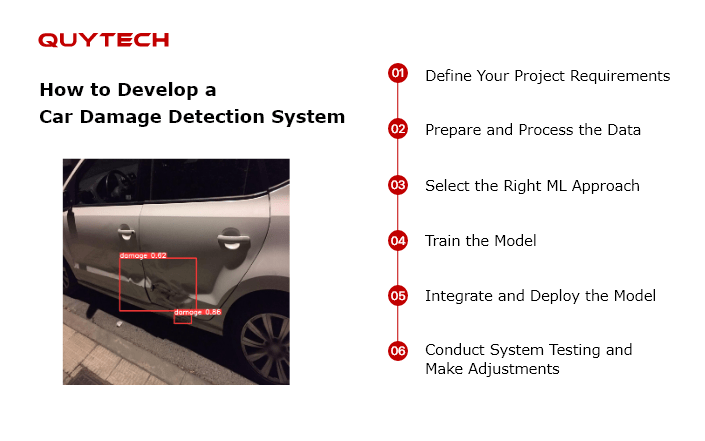
#1 Define Your Project Requirements
The first step is to determine the type and severity of damage you want to detect with the system. It could be only one or all (dents, scratches, cracks, etc.) damages. Mention the capabilities of the system, i.e., whether it would work and provide output in various conditions like daylight, night, indoor, or outdoor.
Clearly, describe the type and format of input data (images, videos, 3D scans, etc.) it would be able to analyze. Define the ways the system will use to generate the output, i.e., damage information. Also, the format in which it will provide the damage information.
#2 Prepare and Process the Data
A car damage detection solution will use machine learning and its algorithms to perform its functions and detect damages. Such models rely completely on clear and vast datasets. Therefore, in this process, collect data, i.e., images and videos of cars, from various sources. The data should be rich and diverse, i.e., it should include images and videos of different types and severity of damages detected from multiple angles and lighting conditions.
Once collected, the next thing to do is to use top annotation tools, such as CVAT, Labelmg, and others) to provide precise labels for different types of images. Also, create bounding boxes around dents, scratches, or other damage. Utilize semantic segmentation to outline the damaged areas.
#3 Select the Right ML Approach
Based on the tasks you want your car damage detection system to perform, choose the right machine learning approach for object detection, semantic segmentation, 3D reconstruction, and deep learning frameworks.
For object detection, you can rely on algorithms like YOLO, SSD, and Faster R-CNN. For semantic segmentation, you can use algorithms such as U-Net, Mask R-CNN, and others. For 3D reconstruction, utilize stereo cameras or LIDAR. For deep learning frameworks, choose from TensorFlow, PyTorch, and Keras.
#4 Train the Model
Train your ML model on the prepared datasets. Perform data preprocessing and continuously evaluate the mode’s performance using various performance metrics. You can also use a separate test dataset to evaluate the ML models’ ability to generalize.
Read More: How to Develop an Intelligent AI Model? A Comprehensive Guide
#5 Integrate and Deploy the Model
The next step in car damage detection software development is to integrate the trained ML model and deploy it into your existing infrastructure or target platform. For this, create APIs to enable other technology solutions to use your system. Also, if you want to integrate it into your mobile application, optimize the trained ML model for targeted mobile devices and platforms.
#6 Conduct System Testing and Make Adjustments
Thoroughly test your computer vision car damage detection system in real-world scenarios to evaluate its performance and the quality of output. Continuously monitor its performance and look for bugs that may impact its functionality. Collect feedback from users and make adjustments, if required.
Choosing the Right Partner for Successful Car Damage Detection System Development
Car damage detection system development requires an individual to have hands-on experience in artificial intelligence, machine learning, computer vision, and other technologies. Besides, they have to have the knowledge of how to develop a solution or software. While building an in-house car damage detection solution is an option, partnering with an experienced technology partner can not only accelerate the development process but also minimize risks and ensure you build successful and high-quality software.
The only thing you need to take care of is choosing the right car damage detection software development company. To help you with that, we have provided some tips below:
- Look for a company or developer with in-depth expertise in machine learning and computer vision. Check how experienced they are in developing object detection, image segmentation, and deep learning models.
- Review their portfolio and case studies section to check their previous projects. It would be an advantage if they have already built a similar solution or have worked with your particular industry.
- Make sure the company has developers with expertise in programming languages like Python, C++, etc., top frameworks, and cloud platforms.
- Check their expertise in AI models, data acquisition & data annotation tools, and quality control techniques.
- Apart from technical expertise, ensure they focus on maintaining clear and regular communication with their client.
- Check the project methodologies they use for successful and seamless #cardamagedetectionsoftwaredevelopment.
- Review their pricing plans and read everything in detail. Ask if they sign a non-disclosure agreement (NDA).
By following these tips, you will be able to find an experienced and trusted vehicle damage detection solution development company.
Conclusion
Car damage detection systems have made it easier for individuals, car rental and automotive companies, insurance firms, and other businesses to automate the detection of damages that may be caused due to any reason. Built using technologies like AI, ML, computer vision, and others, these systems can save time, costs, and effort while ensuring the highest degree of precision in the results.
Curious to know more about car damage detection systems and their development process? This blog is a must-read as it provides the step-by-step car damage detection system development process along with its applications/industry use cases and working. Besides, it helps you with selecting the right partner for developing a car damage detection application or solutions.
